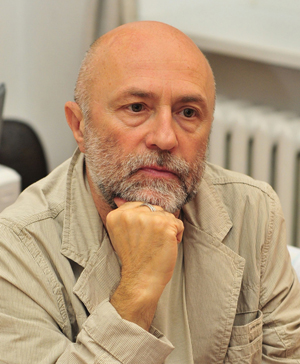Can street art be “framed”?
The large-scale fair ART-KYIVcontemporary 2010 will open within the framework of the presentation of the restored 12 thousand square meters of the Art Arsenal
This year the 5th international art-fair ART-KYIVcontemporary 2010, to be held on November 8-14 in the Art Arsenal, will combine actual gallery and street art in a special street art and media art project. Several original projects will represent street art at the festival. Artists of the famous German art duo molitor&kuzmin, Ursula Molitor and Volodymyr Kuzmin, who work with light installations, will create in the space of the Art Arsenal a construction of neon lamps — a symbol of birth and purity. The Swiss art duo Daniel Glazer&Magdalena Kunz will present unique media-installations and “speaking” kinetic sculptures. The author of unprecedented projects in the genre of visual concerts and electronic poetry, the performance artist Rochus Aust (Germany), the international stars of street art Zevs (France), Incubus Project and Spy (Russia), and the leaders of Ukrainian young art Zhanna Kadyrova, Hamlet Zinkovsky, Anatolii Bielov, Volodymyr Kuznetsov, Mykyta Kadan and Group of Objects will take part in special expositions.
Harald Naegeli, a patriarch of street art, the legendary “sprayer of Zurich,” whose street works in the 1970s disturbed the peace of conservative Europe and opened the history of the street art movement, will be a guest of the festival. Regarding media art, an international video art project will be a significant part of this year’s Art-Kyiv; in addition, a public movie demonstration about street art Exit Through the Gift Shop by the underground graffiti artist Banksy will take place for the first time in Ukraine.
Participants of the international round table “Museum in a Modern Context” will talk about the recent tendencies in the museum concern, the principles of museum exhibit complexes formation, transformation processes in modern museum, the role of collectors and patrons in the activity of museum complexes. Museums and festivals directors and curators from Vienna, New York, Duesseldorf, Berlin, Nizhniy Novgorod, Saint Petersburg, Paris, London, and Seoul will participate in the discussion.
Oleksandr SOLOVYOV, deputy director general for the museum, exhibit activity and art marketing of the Art Arsenal spoke to The Day about the peculiarities of this years’ ART-KYIVcontemporary.
The program of ART-KYIVcontemporary 2010 is abundant in projects and symbolic names. What is especially important for you, as a curator, not from the viewpoint of media publicity but from the viewpoint of the development of both the Art Arsenal and modern Ukrainian art?
“The Art Arsenal is a unique space. First of all, I wonder how several components — commercial (I mean galleries) and non-commercial projects — will come together in this space. Among other things, it is also interesting to see how street art will look within the walls of the Arsenal, which is partly in the ‘street’ state itself, half-museum, half-construction site. Can street art be ‘framed’ by the space of the Art Arsenal? It seems to me this project will look very organic.”
Very respected people will come to the round table “Museum in Modern Context.” The topic is rather broad. What will you try to find out first of all?
“What modern views on the art history are, how this art should be represented in the modern context, which new concepts and tendencies appeared in this regard. Our task is to understand how, for example, history and modernity relate to each other. This is the key question. Art Arsenal is a huge complex, in the future it will be 53 thousand square meters. By the way, at present almost the entire first floor (except for one wing) is ready. This is about 12 thousand square meters.”
Pavlo Makov states that there cannot be a well known artist from an unknown country. Do you think contemporary art can develop in a country stuck in Soviet times and where barbarous laws on art are in place?
“Certainly, this question is not quite art-specific, but speaking about an artist, he or she can emerge in any country. And all other aspects will influence whether the talent will develop freely or will have to break through a wall of concrete.
“Regarding the legislation, of course, it should be amended. And not only the Art Arsenal needs this, but also the Gogol-Fest, the PinchukArtCenter, and generally everyone tied to art.”
By the way, in one of your interviews you mentioned a kind of contemporary-art chain: the Gogol-Fest – the PinchukArtCenter – ART-KYIVcontemporary. Which links does the chain lack?
“The educational system and a productive part, that is the part where this art is ‘produced.’ The Gogol-Fest, the PinchukArtCenter, and ART-KYIVcontemporary are just a presentation of modern art, and we need a link within the framework of which one will not only demonstrate but also create art. In its turn, conditions must be established for this, in particular, an educational system.”
You were a curator at the PinchukArtCenter before. Now you moved to the Art Arsenal. From the viewpoint of your ambitions as a curator, wouldn’t it be more appropriate to stay at the former position and work with international modern art stars than build everything from scratch?
“No, it wouldn’t. Because for me the place where something is born is interesting, I am interested in the process of the competitive modern Ukrainian art formation, which must develop in an international context.”






